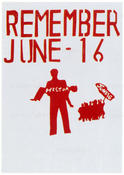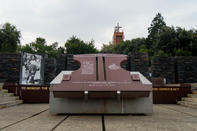Youth Uprising

On the cold, smog-choked morning of June 16, 1976, the children of Soweto awoke with an unusual eagerness. With excitement brimming over on their faces, they dressed as if for school and hastily prepared posters. They poured outdoors, moving through the gloomy streets to converge on Orlando, lines meeting to form a phalanx of youngsters in their black and white uniforms. Tension mounted as the wave of youthful marchers approached the eastern border of Soweto.
The protest march by over 10 000 high school pupils, demanding an end to Afrikaans tuition in their schools, was met on the border of Soweto by a barrage of some 300 heavily armed policemen. Police fired shots into the air to quell the 'riot'. Pandemonium broke loose and in the ensuing mayhem at least one young boy was shot dead and many were wounded.
Suddenly the names of 13-year-old Hector Pieterson and Soweto were in the headlines of the international media. The black residential township of Soweto was brought into the living rooms of people all over America and Europe, and for some time it became the most bandied about word by lobbyists in United Nations corridors.
Police records indicate that during the months of unrest that followed, about 300 people were killed and some 11 000 injured. This does not include the many who did not turn up for treatment at clinics for fear of getting arrested — one means used by the police to arrest 'troublemakers'.
Away with Bantu Education
Until 1968 the men who sat on the advisory boards of local government had provided urban blacks with some token representation. When residents rejected these boards as being 'toothless tigers', Pretoria resorted to its favourite game of sugar-coating the pill.
Advisory boards were 'elevated' to Urban Bantu Councils (UBCs). But Sowetans called Pretoria's bluff when only a handful of voters turned up at the polls to elect these councils. Irreverently the UBCs were referred to as 'urban Bantu circuses'. Although Soweto has always been a barometer of South Africa's black urban political climate, once again Pretoria failed to check the weather.
With typical arrogance and self-deception, the authorities believed that the Soweto UBC had its finger on the township's quickening pulse. Even when the writing was boldly displayed on the walls — all over Soweto the graffiti warned 'We don't want Afrikaans', 'Away with Bantu education', 'Away with slave education' — the authorities were too closeted in their air-conditioned offices to notice anything.
Violent Storm of Protest

On June 16, 1976, Soweto erupted in a violent storm of protest and suppression; Drum, a leading black magazine, headlined the story 'A telegraphed punch'. In boxing parlance (familiar in this sports-crazy township) a telegraphed punch is a clumsy blow that can be seen coming from a long way off and avoided.
The Soweto '76 eruption was just such a blow: it had been heralded since 1953 when the authorities had decided to foist the unwanted, inferior 'Bantu education' system on the millions of blacks who had no say in Pretoria's Government. In 1974 the Nationalist Government announced that certain school subjects would have to be taught through the medium of Afrikaans — the language of the oppressor.
For the previous 23 years warning flashes had sparked across Soweto, but red-faced administration board officials still threw up their arms in disbelief as rampant youths burnt down schools, board-owned beer halls, administration board offices, clinics, community halls and any buildings that had even the most tenuous links with Government. It was as if the officials were crying: 'And after all we've done for you..'
Students of Soweto
Black policemen in the city discarded their uniforms when returning home to Soweto. 'We are afraid of our children', one of them explained frankly. Some of these policemen were known for their zealousness in carrying out the hated laws of apartheid and their houses were petrol-bombed. But the officials should not have felt guilty, or felt betrayed by their Urban Bantu Councils (UBC) lack of foresight of the gathering storm.
Even the South African Police, who boast a highly effective security branch that keeps tabs on political rumblings through an all-pervading system of township informers, were caught unawares. The fact was that while the impimpis (police informers) had their ears to the walls of older activists' houses, the children were scheming on the playing fields.
And it was here that the war against apartheid would be fought. Only a handful of black reporters knew that on that day the students of Soweto would attempt to march to Pretoria to protest against the use of Afrikaans as a medium of instruction in their schools. But nobody, not even student leader Tsietsi Mashinini and his lieutenants, had the vaguest notion that later that day Soweto would be identified by bodies in the streets and columns of deathly black smoke billowing high into the sky.
Over the next few months, scores of black youths would be gunned down in Soweto, many of them shot in the back while running away from teargas and the hail of bullets. Many others would flee the country, some to return later as trained guerrillas.
Soweto Students' Council
Two white board officials were also killed during the uprising. Ironically and tragically, one was Melville Edelstein, a man very sympathetic to the plight of Soweto youths. In 1971 he had been awarded a Masters degree for his thesis on social and political tensions there.
He described the township as ‘a political and sociological hothouse’. With the introduction of Bantu education, the architect of apartheid, Hendrik Verwoerd, had hoped to produce a generation of servile, black invertebrates. Not one to mince his words, Verwoerd stated that the primary aim of Bantu education was to produce ‘drawers of water and hewers of wood’.
But the government was hoisted with its own petard - the system produced a militant, politicized black youth in the Steve Biko mould. Tsietsi Mashinini of the Soweto Students’ Council and the other children who took to the streets on that apocalyptic day were all products of Verwoerd’s apartheid dream.
There was no reason for the administration board to dismiss its Urban Bantu Council (UBC) as a bunch of ignoramuses when even the children of Soweto could never have guessed that that fateful day would come to be recognized as an unofficial national holiday, commemorated every year by the country's black people.
They could also not have guessed that the sparks that ignited Soweto would, within 24 hours, cause a conflagration of protest and resistance across the country. It is a cliché, but nonetheless very true, that when Soweto sneezes, South Africa is bound to catch a cold. Within hours of the Soweto uprising, the whole country was engulfed in a coughing fit.
Daily news reports described incidents of unrest from unheard-of places that news editors could not find on any map. These were the country's black dormitory towns, bursting from their twilight existence into flashlight prominence.
By David Bristow